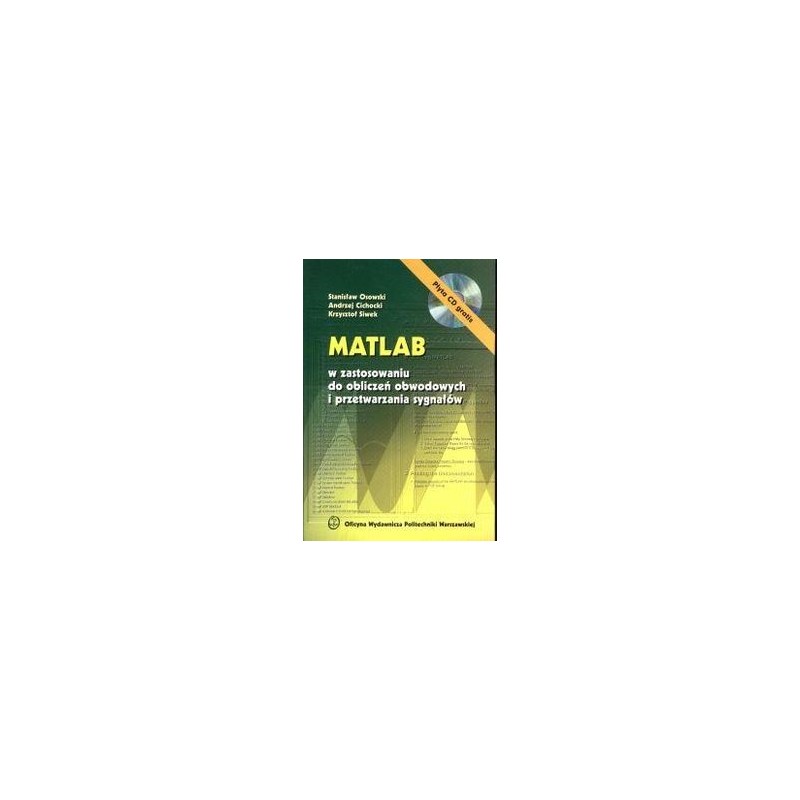- Out-of-Stock



Stanisław Osowski, Andrzej Cichocki, Krzysztof Siwek
About the book
This is the first publication on the Polish publishing market combining the functions of the Matlab / Simulink programming manual and the use of a Matlab / Simulink system with a detailed presentation of numerical methods and algorithms. The manual presents a wide range of Matlab applications in the calculation of electrical and electronic circuits and signal processing. In the application layer the textbook focuses on five basic groups of issues: numerical methods of linear algebra, calculation of electrical circuits in steady and transient states, discrete signal processing, optimization methods in application to the analysis and design of linear and nonlinear circuits as well as computational algorithms of artificial neural networks. In particular, application programs developed on the basis of Matlab are presented for teaching and testing MLP perceptron networks, RBF radial networks and Support Vector Machine (SVM) networks. The last chapter discusses the ICALAB program package containing a set of programs for blind signal separation and deconvolution. This package belongs to the most widely used programs in the field in the world.
The book is accompanied by a CD.
Table of Contents
Preface
1. MATLAB SIMULATION LANGUAGE BASICS
1.1.Wprowadzenie
1.2. Launching the program
1.3. Types and data formats
1.4.Generation of matrices and vectors in Matlab
1.5. Basic matrix and array operations
1.6. Logic operations
Matlab mathematical functions
1.8. Loop organization
1.9. M-files structure
1.10.Other functions and commands used in the m-files structure
1.11 Matlab quadrature and interpolation functions
1.12. Matlab editor / debugger
1.13. Matlab help functions
Tasks and problems
2.GRAPHICS IN MATLAB
2.1. Basic messages
2.3. Basic graphic functions
2.4. Advanced graphic functions
2.5. Three-dimensional art
2.6. Vector scales
2.7. The function of the ezplot function
2.8.Animacje
2.9.Descriptions of drawings
2.10. Saving and printing drawings
Tasks and problems
3. ADVANCED PROGRAMMING IN MATLAB
3.1. Graphic layouts
3.2. Properties of graphic objects
3.3. Creating a graphical user interface in Matlab
3.4. Matlab compiler
Tasks and problems
4. NUMERICAL NUMBERS OF LINEAR ALGEBRA IN MATLAB
4.1. Norms and matrix indices
4.2. Matrix transforms and decomposition
4.3. Advanced matrix operations
4.4. Polynomial relation in Matlab and its application in the theory of circuits
Tasks and problems
5. MATLAB'S APPLICATION IN THE ANALYSIS OF ELECTRICAL CIRCUITS IN THE CONDITION
5.1.Transform description of the circuit in steady state
5.2.Analysis of single-phase linear circuits in steady state
5.3. Analysis of three-phase circuits
5.4.Analysis of electrical circuits with non-sinusoidal forcing
5.5. Sensitivity analysis of linear circuits
5.6. Analysis of nonlinear resistive circuits using staggered approximation
Tasks and problems
6. COMMON DIFFERENTIAL EQUATIONS AND THEIR USE IN THE ANALYSIS OF CONTINUOUS STATUS
6.1.Description of dynamical systems with state equations
6.2. Euler's numerical algorithms for solving state equations
6.3. Numerical integration algorithms assembled in Matlab
6.4. User interface for solving differential equations using a set of ode functions
6.5. Examples of numerical calculations using a set of functions ode
6.6.Translation of transients in RLC circuits with the state variables method
6.7. Differential-differential equations
Tasks and problems
7. SIMULINK PROCESS
7.1.Wprowadzenie
7.2.Models of dynamical systems in Simulink
7.3. Simulink block service
7.4.Simulation of the time domain solution
7.5. Examples of transient simulations in electrical circuits
7.6. Simulation of dynamic states in electric machines
7.7. Specifying balance points in a dynamic system using Simulink
Tasks and problems
8. PROCESSING OF CONTINUOUS AND DISCREET SIGNALS
8.1.Representation of signals in Matlab
8.2. Layout records and their transformations
8.3. Time delays of a linear system
8.4.Characteristics of the frequency of the system
8.5. Matching of frequency characteristics
8.6. The approximation of the frequency characteristics of analog filters
8.7. Designing discrete filters
8.8. Graphical interface for designing filters
Tasks and problems
9. ANALYSIS OF SIGNALS BY MATLAB
9.1. Discrete Fourier transformation
9.2. Statistical analysis of signals
9.3. Spectral analysis of signals
9.4.Exception of signals
9.5. Analysis of main components (PCA)
Tasks and problems
10. OPTIMIZATION FUNCTIONS AND THEIR APPLICATIONS
10.1.Wprowadzenie
10.2. Options for controlling optimization programs
10.3.Examples of using optimization programs
Tasks and problems
11. PROGRAMS FOR LEARNING ARTIFICIAL NEURAL NETWORKS IN MATLAB
11.1. A multi-layered perceptron
11.2. Radial RBF
11.3.Smart Support Vector Machine (SVM)
11.4. Comparative analysis of RBF and SVM networks
Tasks and problems
12. SLEEP SEPARATION AND DECOMPOSITION OF SIGNALS - TOOLBOX ICALAB
12.1.The formulation of the problem of decomposition and blank separation of signals
12.2.Static linear model of blind signal separation
12.3.Dynamic linear model of blank separation
12.4. Choice of the separation criterion
12.5.Algorithms based on second order statistics
12.6.Algorithms based on higher order statistics
12.7.Toolbox ICALAB
12.8.Examples of applications of the ICALAB program
Tasks and problems
Literature
Index
Pocket-sized digital oscilloscope in DIY kit form. Based on an ARM Cortex-M3 core microcontroller, it is equipped with a 320x240 pixel colour display. Fnirsi DSO138 kit
No product available!
The assembled SNAKE electronic game. AVT5554 C
No product available!
No product available!
No product available!
No product available!
Pololu RC Servo Multiplexer 4 Channel (assembled)
No product available!
No product available!
No product available!
No product available!
No product available!
The BBC micro:bit is a pocket-sized computer 16MHz, 32-bit ARM Cortex-M0 microcontroller with 256KB Flash, 16KB RAM that lets you get creative with digital technology. DEV-14208
No product available!
No product available!
No product available!
No product available!
No product available!
NWT7 CIRCUIT ANALYZER - PRINTED PLATE
No product available!

Stanisław Osowski, Andrzej Cichocki, Krzysztof Siwek
